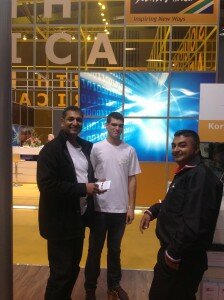CeBIT – Reflections on Day 2
by Prof Barry Dwolatzky

As far as I see it there are two reasons to come to CeBIT – to meet people and to learn new things. On both of these accounts my second day at the world’s biggest ICT trade fair was hugely successful.
I spent some time today meeting exhibitors on the SA National Pavilion. (Isn’t it strange to travel thousands of kilometers to meet fellow South Africans!) There are 14 companies on the Pavilion, most of them are small and innovative with an eye on the future.
I asked some of them to tell me (briefly) what they do and why they’re here. This is what I found out:
- Korwe Software is based in Cape Town. It is represented at CeBIT by Nithia Govender and Tjad Clark. They are launching a new product at CeBIT – a “context engine” that helps mobile users filter information based on their position and other preferences. For example, a vegetarian traveller in Hanover searching for the closest restaurant on her cell phone would get different suggestions compared to her meat-eating companion.
- Wiscor Technologies is from Durban. It’s part of the “Oval Group” who is very active in the tertiary education space. Wiscor’s main offering is “Infiniti Place 2.0” which is a “travelling classroom”. It gives students access to e-lectures, e-books, e-dictionaries and YouTube videos. Wiscor’s software systems satisfy all of the reporting requirements for the SA Council for Higher Education. Pravin Maharaj and Avi Maharaj are representing Wiscor on the National Pavilion at CeBIT.
- “invirohub” is a smart energy monitoring solution. It integrates any compliant smart-meter, energy monitoring and leak detection products into a system that has been used by utilities, municipalities, commercial properties and light industrial clients. Lance Manala is representing the company at CeBIT.
- Mohammed Badat is the CEO of MyVoip Communications. This is his company’s fourth visit to CeBIT. They first came in 2007. MyVoip has an innovative “School Diary” product. They also support clients in implementing SOA-based integration of various systems.
I asked all of these exhibitors whether it was worthwhile coming to CeBIT and if they thought the SA National Pavilion was of value to them. Without exception they all felt coming to CeBIT made good business sense. Lance (from invirohub) said that with help from the CeBIT organisers he had targeted particular companies from all over the world who were offering similar solutions to his. He was able to visit them and learn about what they were doing. This has given him really valuable strategic insights into how he could develop his product in the future.
Pravin Maharaj believes that South Africa’s involvement at CeBIT could be much more effective and valuable if more preparatory work was done beforehand. He makes the interesting point that it is not up to the dti to do this preparation. Companies coming to CeBIT and the SA ICT sector generally need to take responsibility to develop a strategy and marketing material that will enhance our participation at CeBIT.
Watching the comings and goings on the Pavilion and having tens of conversations myself I have no doubt that having a substantial presence at CeBIT is good for the SA ICT Industry and for each of the exhibitors on our Pavilion.

Recent Comments